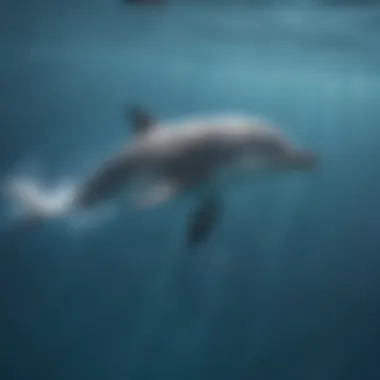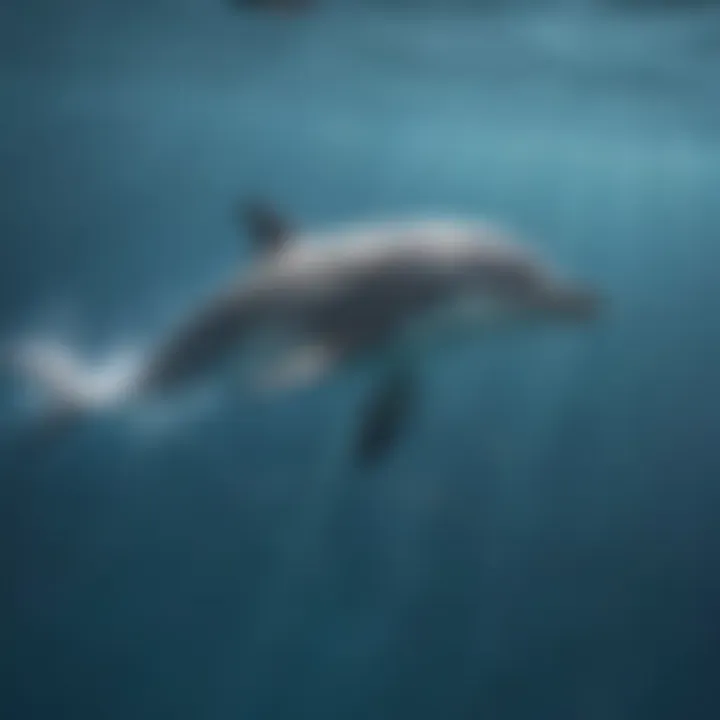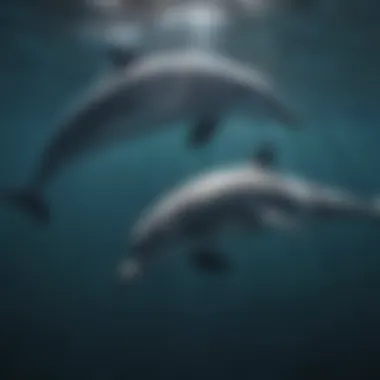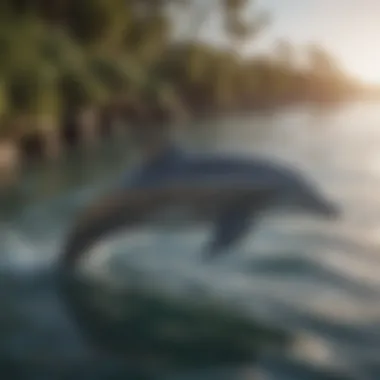Dolphins: A Deep Dive into Their Biology and Conservation


Intro
Dolphins are among the most intelligent and socially complex animals in the ocean. Their ability to communicate, form social bonds, and display problem-solving skills distinguishes them from many other marine species. This article seeks to unravel the biological characteristics, behaviors, and conservation efforts essential to preserving these remarkable marine mammals. With increasing threats stemming from human activities, understanding dolphins' ecology and the challenges they face has never been more critical.
Research Overview
Summary of Key Findings
Dolphins, particularly known for their playful behavior, also exhibit advanced cognitive traits. Research over the years indicates that various species, like the Bottlenose and Orca, possess unique social structures and communication systems. Studies have shown that dolphins can recognize themselves in mirrors, indicating a level of self-awareness not commonly seen in the animal kingdom. Additionally, their acoustic communication, including clicks, whistles, and body language, plays a vital role in their social interactions. Researchers have discovered that dolphins can develop cooperative hunting strategies, demonstrating their ability to work together for mutual benefit.
Relevance to Current Scientific Discussions
The ongoing studies about dolphin behavior resonate with current scientific discussions surrounding animal intelligence and conservation. Understanding dolphins, their social structures, and interaction mechanisms shed light on broader ecological systems and the impacts of human actions. Moreover, insights from dolphin research contribute to debates about marine biodiversity, echoing concerns regarding climate change, habitat destruction, and pollution affecting oceans globally. The findings not only emphasize the need for targeted conservation efforts but also stir conversations surrounding animal rights and welfare.
Methodology
Research Design and Approach
To gather a comprehensive understanding of dolphins, researchers employ a mixed-method approach. Observational studies in both wild and controlled environments facilitate insight into their natural behaviors and social structures. This approach includes compiling data from field studies, laboratory experiments, and existing literature on various dolphin species.
Data Collection and Analysis Techniques
Data collection often involves both qualitative and quantitative techniques. Researchers use underwater acoustic monitoring tools to record dolphin communication. Additionally, direct observations are made to document behavioral patterns and interactions within pods. Advanced technologies, such as drone surveillance and telemetry, aid in tracking movements and habitat use. The analysis of this data uses statistical models to interpret behaviors and assess populations, leading to informed conclusions about the ecological importance of dolphins in their environments.
Prelude to Dolphins
Understanding dolphins is essential due to their ecological significance and the insights they provide into marine life. Dolphins are not only captivating creatures but also play critical roles in their ecosystems. Examining their biology, behavior, and conservation status offers valuable information that can help in preserving these intelligent mammals. This section serves as a precursor to a detailed exploration of the various aspects of dolphin life.
Overview of Dolphin Species
Dolphins belong to the family Delphinidae, which comprises around 36 species. These species inhabit a wide range of marine environments, from coastal regions to open oceans. Notable species include the bottlenose dolphin, orca, and common dolphin. Each species exhibits unique characteristics, adaptations, and behaviors that reflect their habitats. For instance, orcas, also known as killer whales, exhibit complex social structures and hunting techniques, showcasing a high degree of intelligence and adaptability. The diversity among dolphin species reveals the intricate nature of their evolution and adaptation to marine ecosystems.
Dolphins in the Taxonomic Hierarchy
Dolphins hold a fascinating position in the taxonomic hierarchy. They are classified under the order Cetacea, which includes whales and porpoises. Within this order, dolphins are further divided into different families and genera. The prominent family of dolphins is Delphinidae. This classification underscores the biological characteristics that dolphins share with other cetaceans, such as streamlined bodies and the ability to communicate through echolocation. Furthermore, understanding their taxonomy helps researchers pinpoint the evolutionary relationships between species, facilitating conservation strategies tailored to specific dolphins.
"Dolphins possess a remarkable level of intelligence, showcasing complex social behaviors and communication methods, essential for their survival in the wild."
In summary, the introduction to dolphins sets the stage for a deeper understanding of their biology, ecology, and the numerous challenges they face in today's world. By gaining insights into various species and their taxonomic classifications, one can appreciate the complexity of these marine mammals and the necessity of their conservation.
Biological Characteristics of Dolphins
Understanding the biological characteristics of dolphins is crucial for comprehending their behavior and role in marine ecosystems. These characteristics not only define their physical presence in water but also influence their social interactions and ecological contributions.
Physical Attributes
Dolphins are known for their streamlined bodies, which are adapted for an aquatic environment. The skin of a dolphin is smooth and covered with a thin layer of blubber that provides insulation. This blubber is essential for surviving in varying water temperatures, allowing dolphins to thrive in both warm and cool waters.
Coloration varies among species, ranging from gray to complex patterns of black and white. The dorsal fin is another significant trait, playing a role in stability and balance while swimming. In addition, dolphins possess a telescopic eye structure, providing excellent vision underwater. Their size can also vary, with larger species, like the orca, reaching lengths of over 30 feet, while smaller species, such as the bottlenose dolphin, average around 8-12 feet.
Physiology and Anatomy
Dolphins have a remarkable physiology that allows them to adapt to life in water. They exhibit a unique adaptation known as pulmonary adaptations, which enable efficient oxygen exchange and minimize the risk of decompression sickness during deep dives. Dolphins can hold their breath for significant periods, usually around 10 to 20 minutes, depending on the species.
The anatomy of dolphins includes a highly developed brain, which is larger in proportion to body size than in many other mammals. This complexity is tied to their sophisticated social behaviors and communication skills. Additionally, dolphins possess specialized organs such as the melon, used for echolocation. This ability to produce sound waves and interpret the returning echoes is crucial for navigation and hunting.


Reproductive Biology
Dolphin reproduction is characterized by its complexity and the social bonds formed during mating and rearing of young. Female dolphins generally exhibit a 12-month gestation period. After this time, they give birth to a single calf, which is nursed for up to two years. Dolphins are known for their strong maternal care, with mothers guiding and teaching their offspring essential survival skills.
The social structure around reproduction can vary. In some species, males may engage in aleatory mating systems, where they compete for females in a display of strength and agility. Mating behaviors also reflect the co-operative social bonds dolphins form within pods, influencing the genetic diversity crucial for healthy populations.
"Dolphins are complex creatures, and understanding their biology is essential for effective conservation strategies."
Behavior and Social Structure
The study of dolphin behavior and social structure reveals significant insights into their environmental adaptations, cognitive abilities, and social interactions. Understanding how dolphins interact within their pods contributes to the broader comprehension of their biology and conservation needs. Pods serve as the primary social units for dolphins, influencing not just individual behaviors but also community dynamics. Examining these structures is essential for developing effective conservation strategies, as the social structures can inform about their resilience to environmental changes.
Social Organization within Pods
Dolphin pods vary in size and composition, ranging from a few individuals to over a hundred. Most species exhibit a fission-fusion dynamic, meaning that group formations frequently change. This fluidity allows dolphins to utilize various social relationships, which enhance their foraging efficiency and protection against predators. Within pods, intricate hierarchies can be observed. Often, dominant individuals—usually females—play crucial roles in group decision making, including hunting and navigation. These social structures help in resource allocation, ensuring that all members benefit from collective activities.
- Dolphin social structures include:
- Matriarchal leadership: Dominant females often direct pod movements.
- Cooperative hunting: Groups work together to catch prey.
- Complex social bonds: Relationships can be strong, fostering cooperation.
These relationships often lead to learned behaviors passed down across generations, showing cultural aspects of their societies. Research indicates that dolphins can recognize individuals within pods, suggesting a sophisticated level of social memory.
Communication and Vocalization
Dolphins are known for their remarkable communication skills. They utilize a variety of sounds, including clicks, whistles, and body movements, to convey messages to one another. Each dolphin has a unique signature whistle, which functions like a name. This allows them to call out to specific individuals when needed.
The significance of effective communication cannot be overstated, especially in social contexts where coordination is vital for activities like hunting. Dolphins also use echolocation, emitting sound waves that bounce off objects, enabling them to navigate and hunt efficiently.
Communication forms include:
- Clicks: Used primarily for echolocation and orientation.
- Whistles: Often serve as social calls among dolphins.
- Body language: Includes leaping, surfing, and posturing to express mood or intentions.
By studying their vocalizations, researchers can distinguish between different social behaviors and emotional states. This understanding has implications for dolphin rehabilitation efforts in stranded or captured individuals.
Play and Intelligence
Dolphins exhibit complex play behaviors that are integral to social bonding and cognitive development. Activities may include surfing on waves, playing with seaweed, or engaging in games with other dolphins. Play is not just entertainment; it facilitates learning and strengthens social bonds within pods. Through playful interactions, dolphins develop problem-solving skills and enhance their cognitive functions.
Several indicators demonstrate dolphin intelligence, including:
- Ability to understand complex tasks.
- Capacity for self-recognition in mirrors.
- Use of tools, such as sponges for foraging.
Research suggests that play can also stimulate mental health, providing relief from stress. Recognizing the importance of play can aid in creating environments that support dolphin well-being in captivity or during rehabilitation.
"Understanding dolphin social behavior and intelligence is key to their conservation and management in the wild." - Marine Biologist
Dolphins and Their Habitat
Understanding the habitat of dolphins is essential for a holistic view of their biology and conservation needs. Dolphins inhabit a variety of marine environments, which directly affect their behavior, social structures, and overall well-being. This section examines the diverse habitats of dolphins and the significance these environments hold for their survival.
Marine Environments
Dolphins are primarily found in oceanic waters, but they also inhabit coastal areas, bays, and rivers. The diversity of marine environments where they reside contributes significantly to their adaptability and distribution.
- Oceanic Zones: Many dolphins, like the common bottlenose dolphin, thrive in the open ocean, which features a vast expanse of water with rapid currents and diverse marine life. The availability of prey, such as fish and squid, influences their movements and group dynamics.
- Coastal Regions: Dolphins frequently frequent coastal areas because of the abundance of food sources and shallower waters. These regions also offer lagoons and estuaries that serve as critical nurseries for young dolphins. The intertidal zones provide varied ecosystems where dolphins can find both shelter and food.
- Polar and Tropical Waters: Different species of dolphins are adapted to specific climate zones. For example, the orca, or killer whale, can be found in colder waters, while species like the spinner dolphin are more common in warmer, tropical locales. This adaptability showcases the physiological and behavioral flexibility of dolphins to thrive in diverse marine environments.
Migration Patterns


Dolphins display notable migration behaviors based on seasonal shifts and environmental factors. Understanding these patterns is vital for assessing their ecological needs and conservation strategies.
- Seasonal Migration: Many dolphin species migrate in response to temperature changes and prey availability. In colder months, dolphins may move to warmer waters where food is more plentiful.
- Breeding and Nursery Areas: Migration is also influenced by breeding cycles. Dolphins often travel to specific areas conducive to breeding and where young calves can grow safely. These migration routes are crucial for population sustainability.
"Migration patterns not only reflect the adaptability of dolphins but also highlight how changes in environmental conditions can impact their survival."
- Influencing Factors: Light, water temperature, and food availability serve as cues for dolphins as they navigate and migrate across large distances. These factors underscore the importance of preserving their habitats, as any disruption can lead to a decline in population numbers.
In summary, dolphins are integral parts of marine ecosystems. Their habitats and migration patterns reveal much about their role in the ocean's health. Recognizing the diverse environments they inhabit is a step toward ensuring their conservation and understanding the vital ecosystems they rely on.
Dolphins in Culture and Society
Understanding the role of dolphins in culture and society provides valuable insights into how humans perceive and interact with these marine mammals. Dolphins have inspired art, mythology, and literature across various cultures. Their representation often signifies intelligence, agility, and playfulness. Moreover, this section will explore how these qualities have influenced dolphin conservation efforts and the broader relationship between humans and dolphins. The cultural significance of dolphins extends beyond mere symbolism, highlighting their impact on identity, tradition, and community values.
Symbolism in Various Cultures
Throughout history, dolphins have held a prominent place in human culture, representing different things across various societies. In ancient Greek mythology, dolphins are often seen as messengers of the gods. They were regarded as saviors to sailors, guiding lost ships to safety. In India, some cultures view them as sacred creatures linked to the divine. Various indigenous tribes in the Americas also believe dolphins possess spiritual significance.
- In Native American Culture: Dolphins symbolize harmony and balance. They embody the interconnectedness of life.
- In Asian Cultures: They are often seen as protectors of the sea, influencing local folklore.
These cultural interpretations underscore the respect and reverence many societies have for dolphins. This symbolic connection fosters increased awareness of their conservation needs. Communities often rally around their local dolphin populations, emphasizing the necessity of protecting their habitats.
Dolphins in Entertainment
Dolphins have significantly influenced the entertainment industry, captivating audiences through films, performances, and theme parks. The portrayal of dolphins in movies, such as "Flipper" and "Dolphin Tale," highlights their appeal and intelligence. This has led to an increased public interest in their conservation, as the stories resonate on emotional levels.
Moreover, many marine parks and aquariums use dolphins in shows and educational programs, emphasizing their playful nature. However, this practice is not without controversy. Critics argue that the conditions of captivity can be detrimental to dolphin well-being. The debate on ethical treatment is crucial in discussions about dolphin entertainment.
Here are some considerations related to dolphins in entertainment:
- Conservation Awareness: Shows can raise funds for dolphin conservation initiatives.
- Public Education: Educational programs help disseminate important information about dolphin biology and ecology.
- Ethical Concerns: Questions arise about animal welfare and the impacts of captivity on mental health and social structures.
While dolphins in culture and society symbolize intelligence and grace, it is vital to approach their entertainment portrayal with caution.
This balanced understanding of dolphins transcends entertainment and enters conservation discussions, influencing efforts to protect these remarkable creatures.
Threats to Dolphin Populations
Understanding the threats to dolphin populations is crucial, as it highlights the challenges these intelligent marine mammals face in their natural habitats. Globally, the decline in dolphin numbers is alarming. These threats come from various sources, impacting not only dolphins but also the entire marine ecosystem they inhabit. Different aspects of these threats warrant close examination, both for scientific insight and conservation efforts.
Environmental Challenges
Dolphins, as highly adapted marine mammals, rely heavily on their environment for survival. Environmental challenges include pollution, climate change, and habitat degradation.
- Pollution: Chemicals, plastics, and heavy metals find their way into oceans, adversely affecting dolphin health. For instance, the accumulation of toxins in the marine food chain jeopardizes their immune system, reproduction, and overall wellbeing.
- Climate Change: Rising ocean temperatures result in altered habitats and food availability, exerting stress on dolphin populations. Ecosystems such as coral reefs, crucial for many species of fish, are threatened. This can lead to a decline in prey availability for dolphins, forcing them to move to new areas, potentially exposing them to more dangers.
- Habitat Degradation: Activities such as coastal development and maritime traffic disrupt dolphin habitats. Such disruptions can lead to loss of breeding grounds and areas essential for feeding, ultimately influencing dolphin populations negatively.
Human Impact and Exploitation
Human activity significantly impacts dolphin populations through direct and indirect means. These impacts can be immediate or gradual, but all share a common consequence: a threat to dolphin survival.
- Bycatch: In fishing operations, dolphins often become unintended victims, caught in nets intended for other species. This phenomenon not only poses a direct threat to their numbers but also disrupts social structures within pods.
- Captivity: Capturing dolphins for entertainment or aquariums raises ethical concerns. The stress and health complications arising from this process not only threaten individual dolphins but can also affect the genetic diversity of the population.
- Marine Traffic: Increased boat traffic in coastal areas poses danger through collisions. Noise pollution from vessels can interfere with dolphins' communication and navigation. Furthermore, potential habitat destruction from marine infrastructure development further exacerbates their situation.
"The plight of dolphins underscores a more extensive environmental crisis, intertwining human activity with the fate of marine wildlife."
Combating these threats requires collective action, awareness, and sustainable practices. Addressing both environmental challenges and human impact is essential to ensure the survival of dolphin populations and, by extension, the health of our oceans.


Conservation Efforts for Dolphins
Dolphins are among the most intelligent and social creatures of the ocean, yet they face numerous threats that jeopardize their survival. Understanding the significance of conservation efforts is paramount for maintaining dolphin populations and preserving marine ecosystems. These efforts are not merely about saving dolphins; they are also about ensuring a balanced environment where many species, including humans, benefit from healthy oceans. Addressing the challenges dolphins face requires global cooperation, advanced research, and community engagement.
Global Initiatives
A variety of global initiatives focus on dolphin conservation. These programs typically involve multiple stakeholders, including governments, non-profit organizations, and research institutions. One prominent effort is the Marine Mammal Protection Act in the United States, which safeguards all marine mammals and their habitats. This act highlights the necessity of enforcing laws designed to protect dolphins from threats such as habitat loss and hunting.
International agreements, like the Convention on International Trade in Endangered Species (CITES), also play a crucial role by regulating trade in species that are threatened or endangered. Animals like the Vaquita, a small porpoise found in the Gulf of California, have benefitted from such international protections.
In addition to legislative measures, various organizations, such as The Dolphin Project and Ocean Conservancy, conduct research and work directly in the field. They monitor dolphin populations, providing valuable data to inform policies and promote awareness. Collaborations across borders ensure comprehensive approaches to dolphin protection.
"Global cooperative efforts are essential for achieving effective dolphin conservation, since these animals roam vast oceanic areas often transcending national boundaries."
Community Involvement
Community involvement is a key component of successful dolphin conservation efforts. Local communities are integral when it comes to implementing and supporting conservation strategies. Education plays a major role in this. By raising awareness regarding the importance of dolphins and their role in the ecosystem, communities can foster positive attitudes toward marine protection.
Grassroots organizations often help mobilize local populations. For instance, programs that engage school students in conservation activities can instill a sense of responsibility toward nature from a young age. Workshops, beach clean-ups, and citizen science projects can attract participation and inspire long-term commitment to dolphin safety.
In many regions, eco-tourism represents a valuable opportunity for community-driven conservation. Responsible dolphin-watching tours, which prioritize the well-being of animals, can generate income while also educating visitors about marine ecology. This creates an incentive for local communities to protect their marine environments rather than exploiting them.
In summary, conservation efforts for dolphins encompass numerous layers—from international policies to local initiatives. A multifaceted approach, involving collaboration and community engagement, is vital to ensure that dolphins continue to thrive in our oceans.
Future Implications and Research
Understanding future implications and research related to dolphins is crucial for various reasons. It informs conservation strategies, enhances our comprehension of dolphin dynamics, and highlights areas needing focused investigations. As the oceanic environment changes, so does the role dolphins play in these ecosystems. Addressing these changes can lead to better management practices that secure their habitats, which in turn benefits entire marine ecosystems.
Advancements in Dolphin Research
Recent advancements in dolphin research have opened new pathways for understanding their behaviors and biology. Studies have made use of innovative techniques, such as satellite tracking and biomonitoring, which allow scientists to gather unprecedented amounts of data. For instance, research on dolphin acoustic signals has revealed complexities in communication, challenging our previous perceptions of their social structures.
Moreover, genetic research has also progressed, helping to clarify the evolutionary relationships between different dolphin species. These advancements not only contribute to scientific knowledge but are also vital for implementing effective conservation practices. For example, understanding genetic diversity can inform how populations adapt to environmental stresses.
"Investments in dolphin research yield high returns in ecological stability, ensuring that these marine mammals continue to thrive in their natural habitats."
The Role of Technology in Dolphin Conservation
Technology plays a significant role in dolphin conservation efforts. Modern conservation practices employ various tools, including underwater drones and acoustic monitoring devices. These tools help in the real-time observation of dolphin populations and their behaviors without interfering with their natural habitats. Utilizing drones, for instance, can supply valuable data regarding dolphin distribution and behavior patterns without the need for direct human interaction.
Additionally, technology facilitates public engagement through mobile applications that promote citizen science. By allowing enthusiasts to report sightings and behaviors, we increase data collection while raising awareness about dolphin conservation efforts. This synergy between technology and public involvement supports the creation of a more informed society regarding marine conservation.
The ongoing advancements in research methodologies and the integration of technology into conservation strategies are not just beneficial but essential for safeguarding dolphin populations against existing and emerging threats.
End
Understanding dolphins is crucial to catching their importance in marine ecosystems. They inhabit various oceanic environments and play vital roles in maintaining the health of those ecosystems. This article highlights a wide range of significant aspects regarding dolphins, covering their biology, social structures, and conservation efforts.
Summary of Key Points
This article emphasizes:
- Biological aspects: Dolphins have unique physical and physiological characteristics that enable them to thrive in aquatic environments. They possess complex anatomy that aids in swimming and feeding.
- Behavioral traits: Dolphins exhibit intricate social behavior. Pods can consist of individuals with strong social bonds. Their communication skills are impressive, often using clicks, whistles, and body language to interact.
- Conservation issues: Dolphins face numerous threats, including habitat loss, pollution, and hunting. The decline in their populations raises alarms about ocean health and biodiversity.
- Conservation efforts: Various global and local initiatives focus on the protection of dolphins, involving communities in conservation. This section details how collaborative efforts can make significant impacts.
"Dolphins are not just intelligent marine mammals; they are indicators of our ocean's health. Protecting them is essential for overall marine conservation."
Call to Action for Conservation
Given the challenges dolphins face, active involvement in conservation demands urgent attention. Here are some steps that individuals and organizations can take:
- Advocate for policies that reduce pollution and habitat destruction.
- Support organizations involved in dolphin rescue and rehabilitatoin efforts.
- Educate others about dolphin conservation, emphasizing their role in marine ecosystems.
- Participate in community-based initiatives, such as beach clean-ups and awareness programs.
Dolphins deserve protection, not only for their inherent value but also for the health of the oceans. Every effort counts in this collective endeavor.



